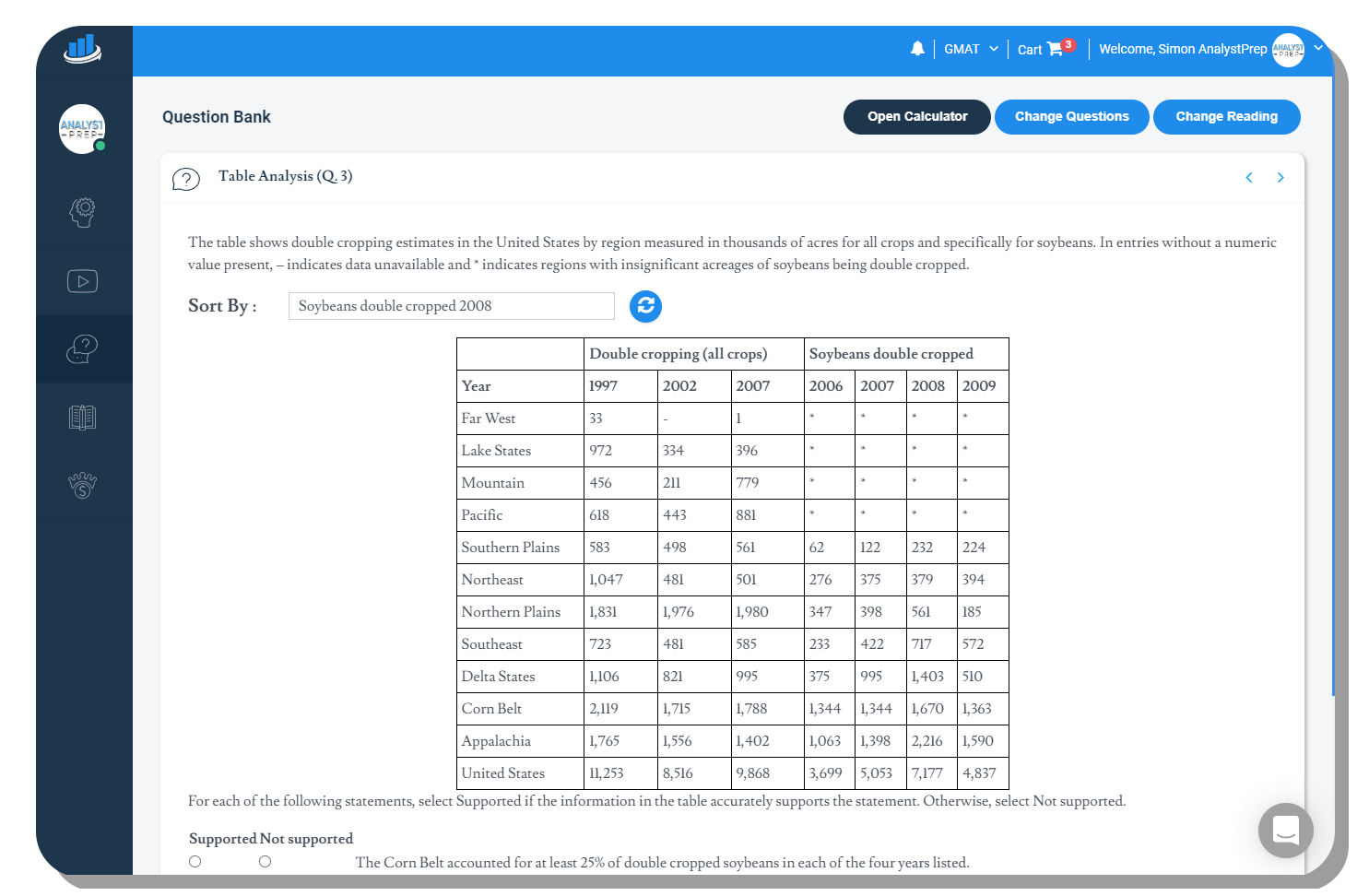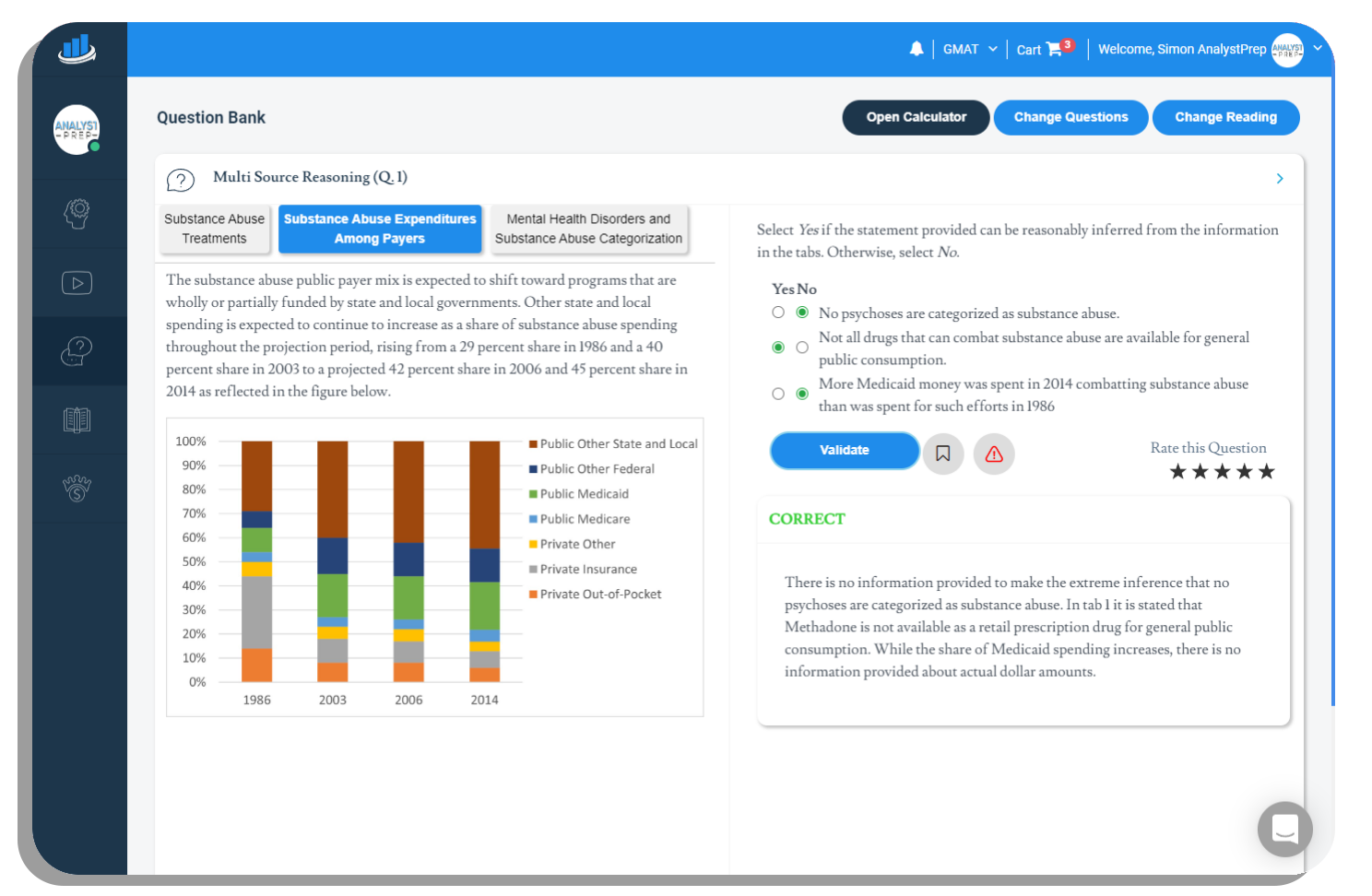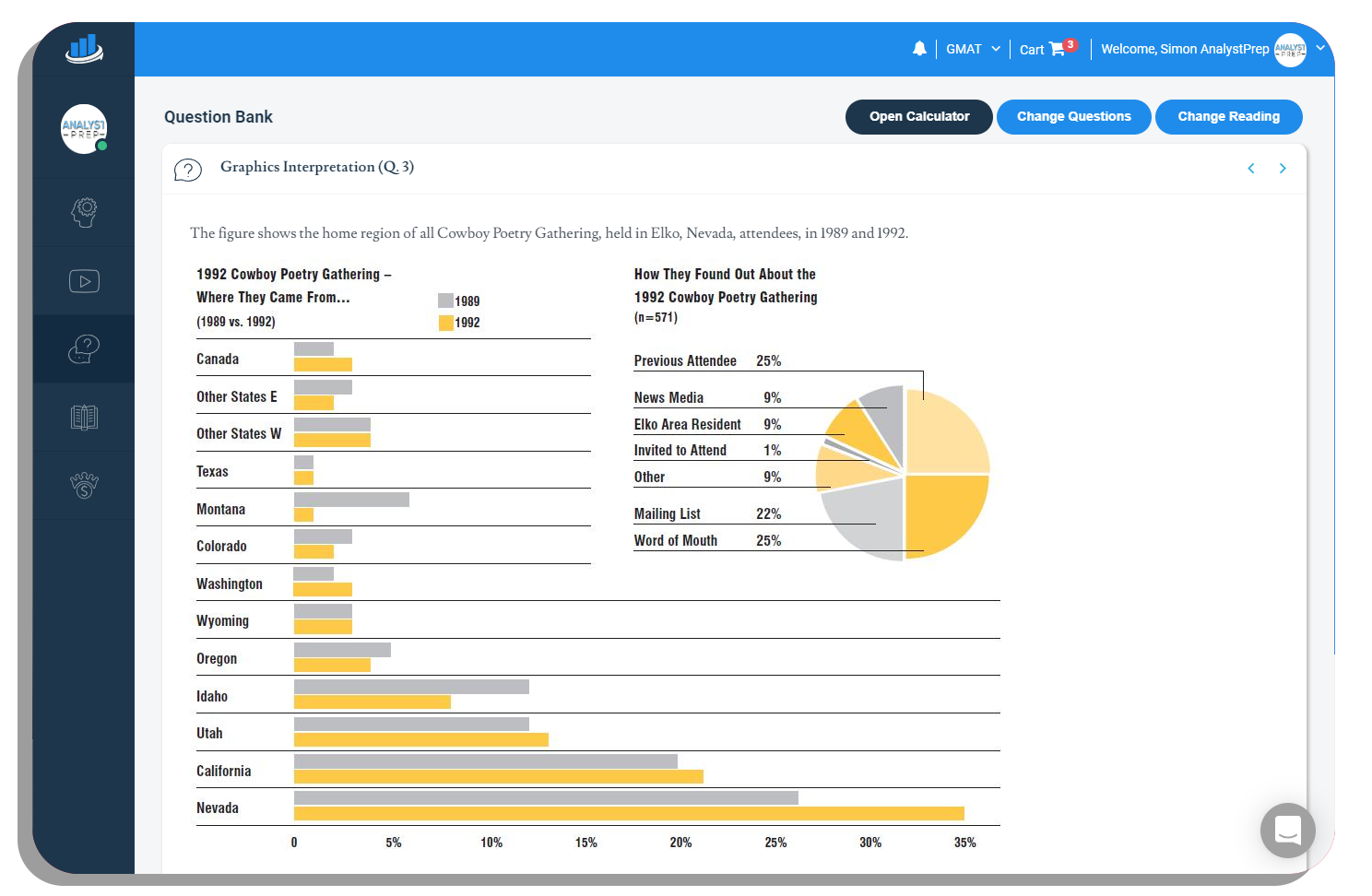GMAT® Focus Data Insight Questions
Data Sufficiency
Table Analysis
Multi-Source Reasoning
Two-Part Analysis
Graphics Interpretation

Types of Questions to Expect in the GMAT Focus Data Insight Section
A Look at AnalystPrep's Preparation Platform for Integrated Reasoning Questions


What to Expect in the Data Insight Section of the GMAT Focus Exam
In the Data Insights section of the GMAT Focus Edition, candidates encounter a variety of tasks that assess their ability to interpret and apply data in business scenarios. This section, composed of 20 questions, replaces the traditional Integrated Reasoning section and is tailored to the modern business environment. Here’s what to expect in the Data Insights section:
- Synthesizing and Analyzing Data: Candidates must interpret data presented in various formats, including text, numbers, and graphics. This involves a deep analysis of the data to extract meaningful insights.
- Evaluating Data from Multiple Sources: The section requires candidates to consider information from different sources, emphasizing the importance of integrating these pieces of information to form a coherent analysis.
- Complex Problem-Solving with Data: Just like in the traditional Integrated Reasoning section, the Data Insights section demands the manipulation and application of data to solve intricate problems, often involving multiple steps or stages.
- Data Organization and Relationship Analysis: Similar to table analysis in the old format, this new section involves sorting through and organizing data, identifying relationships and patterns to solve interconnected problems.
How Scores are Reported in the Data Insight Section of the GMAT Focus Exam
Regarding scoring, the Data Insights section contributes to the overall GMAT Focus score, which ranges from 205 to 805. The scoring for this section, however, isn’t reported separately like the Integrated Reasoning section in the traditional GMAT, where scores ranged from 1 to 8. As in the previous format, some questions in the Data Insights section may consist of multiple parts, and candidates need to answer all parts correctly to receive full credit for the question, with no partial credit awarded for incomplete or partially correct answers.
Table Analysis
In this section, you’ll be given a sortable table of data similar to a spreadsheet, which you’re required to analyze and determine whether the answer statements are correct based on the information provided. Table analysis combines two skills – making logical deductions and breaking down tabular data.
The main challenge you’ll face when handling table analysis questions is facing a new set of data and figuring out how to fit all those pieces together. Table analysis is meant to determine your skills in solving real-world problems. Since you’ve already dealt with plenty of spreadsheets in your life, it shouldn’t be challenging to interpret this sort of data.
Multi-Source Reasoning
Multi-source reasoning offers three pieces of information on tabbed pages – data, tables, articles, emails, etc. While these pieces provide lots of information, not all of it is necessary to answer the question. The information provided may be quantitative or verbal in nature, or sometimes a combination of both. While working on these three pieces of information you may be required to click back and forth between them and locate the needed data.
The questions consist of either a set of yes/no statements or multiple-choice questions. You’ll need information from multiple tabs to answer the questions. However, you can use the same tab to answer more than one question. The questions in this category are designed to mimic the case study approach used by most management programs, therefore, examining one’s ability to put together different types of information from different sources.
Two-Part Analysis
In two-part analysis, you’ll be given a task that involves two components. It’s worth noting that each question is more than one question and based on the passage provided, you’ll be asked to evaluate two things – they could be definitions of two terms or two completely separate issues. Solving this kind of question isn’t usually complicated. However, it requires more work as you’re required to answer more than one question. Answers in two-part analysis can take multiple forms. You might be asked to fill in a black using a pull-down menu that provides multiple choices or answer a traditional multiple-choice question. Moreover, you may be required to select certain options in a table or give answers to two statements in the form of yes/no or true/false.
It’s worth noting that sometimes the two sections of a two-part analysis question may depend on each other or may be determined independently. Whichever the case, you only get credit if both halves are answered correctly.
Graphics Interpretation
Graphics representation questions require you to interpret a graph or graphical image in order to select the correct response from the choices provided based on the information you get from the graphs. These types of questions will always contain a graph and are designed to test your ability to analyze and interpret the information presented therein. In most cases, you’ll come across traditional graphs such as pie charts or bar graphs. However, in some cases, you may also see more unusual graphs, which shouldn’t be a cause for concern as the questions are answered the same way as those for traditional graphics.
The types of graphs you’ll come across include:
- Bar graphs
- Line graphs
- Flow charts
- Organization charts
- Venn diagrams
- Scatter plots
It’s advisable to read the introductory text before examining the graph. At the start, don’t try to analyze the graph. Instead, take a few moments to know how the graph works and the kind of information it represents. Since Graphics interpretation questions are usually less dense compared to other types of questions in the Data Insight section, you should spend less time here.
How Many Hours Should You Devote?
It’s recommended that one should start studying at least 3 – 6 months before sitting for the exams. In order to achieve an overall score of 700+ in the GMAT Focus exam, it’s advisable to devote 120-150 hours of prep time. That means, from this total of 120-150 hours, you should spend approximately 30 hours or more learning about the questions you expect in the integrated reasoning section using real-exam scenarios.
Benefit of Study Materials Provided by Exam Preparation Platforms
Studying alone can be daunting, especially if you’re planning to take your GMAT exam within a given timeframe. Taking a GMAT prep course not only gives you a sense of structure to your studying but also helps you maintain the discipline required for efficient study. Instead of sitting down each day to decide what you’re going to study, a GMAT prep course like AnalystPrep will have all the study content divided up into modules or blocks to ease your work. All you need to do is flip through the pages or the slides provided.
With lots of study resources, including video lessons, study notes, and practice questions, you’ve got everything at your disposal to prepare adequately for the GMAT exam. Given that most prep course materials are prepared based on current exam trends and difficulty levels, you’ve got the opportunity to study under real exam conditions. If anything, you get to discover specific task-taking tips and tricks that can improve your guessing accuracy, exam timing, and overall efficiency.
FAQs About the Graphical Section of Data Insights
| What’s the time allocation for questions in the Data Insight section? | The Data Insights section of the GMAT Focus Edition is allocated a total of 45 minutes. This time frame is for completing all 20 questions in the section, which involves various tasks such as data analysis, interpretation, and application to real-world business scenarios. |
| Can I go back and change the answer after I’ve answered a question? | In the GMAT Focus Edition, you have the flexibility to review and change your answers for up to three questions per section. This feature allows you to bookmark and review as many questions as you want within the time remaining for that section, giving you the opportunity to optimize your test-taking strategy. This is a significant change from the previous versions of the GMAT, where you couldn’t go back and change answers once you had moved on to the next question. |
| Do I need a calculator for Data Insight section? | Yes, you are allowed to use a calculator for the Data Insights section in the GMAT Focus Edition. This calculator will be provided on the screen during the exam, so you don’t need to bring your own. The calculator is specifically permitted for this section to assist with data analysis tasks that may require calculations. |
| Do you get partial credit if you get one part of a single question correct? | Unfortunately, you get a credit only when you answer all the parts of a single question correct. No partial credit is given for questions in the GMAT Focus Data Insight section. |

Compare Yourself to Other Candidates
AnalystPrep’s Preparation Platform includes an advanced built-in analytics software that allows you to keep track of your progress by monitoring your performance and comparing it to a class average. View your stats easily in attractive charts and quickly identify your strengths and weaknesses. Then, adapt your study method and improve your strategy in the areas that need more attention. Finally, compare your results with thousands of candidates who join AnalystPrep’s Prep Platform each year and stay motivated in your study sessions.

Questions Answered by our Users
Satisfied Customers
Preparation Platform By Review Websites
GMAT® Focus Prep Packages
GMAT Focus Complete Course
$
39
/ month
- Conceptual Video Lessons
- Quantitative Practice Problems
- Verbal Practice Problems
- Data Insight Practice Problems
- Customizable Quizzes
- Performance Tracking Tools








